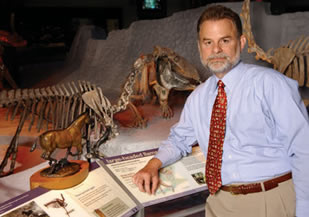|
|
Ideas About Fossil Horses Evolvedownloadable pdfThe old gray mare, she ain’t what she used to be, says a University of Florida researcher whose findings show that the evolution of horses had more twists and turns than previously thought. According to conventional notions, horses simply became bigger over time and switched from being diminutive shrub nibblers to the statuesque, grass-eating masters of the open plains, said Bruce MacFadden, a UF paleontologist whose research appeared in the March 17 issue of the journal Science. But the new horse sense is that the equine mammals are adaptable critters whose size, diet and range depended on geography and climate, he said.
“The old ideas about how horses evolved made for a fairly simple and tidy story,” said MacFadden, whose 1992 book “Fossil Horses” is considered the definitive work on the subject. “But many of the concepts about horse evolution that came into being during the 20th century are now outmoded, giving way to an understanding of the fossil horse sequence that is much more complex.” Because horses have been around a long time, learning about their evolution provides unusual insight into the patterns of evolution in general, said MacFadden, who works at UF’s Florida Museum of Natural History. “Horses are a very good example because there is a long, continuous fossilsequence of horses extending 55 million years in North America, providing the tangible evidence to trace individual steps or changes in evolution over a prolonged period of time,” he said. Children often learn in social studies classes how the Spaniards brought horses to the New World in the 1500s, eventually producing vast herds of wild horses on the prairies and helping to create America’s legendary cowboys, MacFadden said. But the fossil record shows horses actually originated in North America at least 55 million years ago and roamed the continent before becoming extinct at the end of the last Ice Age, about 10,000 years ago, he said. Scientists once universally thought the more primitive horses, which lived from about 55 million to 20 million years ago, were primarily leaf-eating browsers, only becoming grass eaters as the prairie grasslands began to spread rapidly across North America during the Miocene Epoch about 20 million years ago, MacFadden said. The reality is not so clear-cut, MacFadden said. Actually, during times of transition, some groups of horses became mixed feeders, eating both grasses and leafy material, he said. MacFadden analyzed the chemistry of fossilized teeth to determine horse diets. Animals incorporate into their skeletons and teeth the carbon content of the plants they eat, he said, and grasses photosynthesize carbon differently than do leaves, shrubs or trees. John Flynn, Frick Curator of fossil mammals at the American Museum of Natural History, said MacFadden’s findings are important because the history of horses has been one of the mainstays of evolutionary studies, biology textbooks and museum exhibits since the 1800s. “Bruce MacFadden’s Science ‘Perspective’ on horse evolution elegantly summarizes the latest information on their fossil record, and the knowledge that continues to arise from a wide variety of analyses of both new discoveries and existing fossils,” Flynn said. “And there’s no one better than Dr. MacFadden to provide this synthesis, since Bruce has long been a world leader in understanding horses, past and present.” Just as the scientific knowledge about whether horses were browsers or grazers has changed, so have ideas about the evolution of body size, he said. The preconceived notion that the horse was once as small as a dog but progressively grew to its present stature now can be proven to be incorrect, MacFadden said. About 20 million years ago during the Miocene Epoch, horses diversified in size rather than just becoming larger, MacFadden said. While some grew larger, others became smaller or remained the same size, he said. Bruce MacFadden, bmacfadd@flmnh.ufl.edu
|

